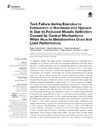Identificador persistente para citar o vincular este elemento:
https://accedacris.ulpgc.es/jspui/handle/10553/52631
| Título: | Task failure during exercise to exhaustion in normoxia and hypoxia is due to reduced muscle activation caused by central mechanisms while muscle metaboreflex does not limit performance | Autores/as: | Torres-Peralta, Rafael Morales Alamo, David González-Izal, Miriam Losa-Reyna, José Pérez-Suárez, Ismael Calbet, Jose A. L. Izquierdo, Mikel |
Clasificación UNESCO: | 2411 Fisiología humana | Palabras clave: | Electromyography EMG Exhaustion Fatigue High-intensity, et al. |
Fecha de publicación: | 2016 | Publicación seriada: | Frontiers in Physiology | Resumen: | To determine whether task failure during incremental exercise to exhaustion (IE) is principally due to reduced neural drive and increased metaboreflex activation eleven men (22 ± 2 years) performed a 10 s control isokinetic sprint (IS; 80 rpm) after a short warm-up. This was immediately followed by an IE in normoxia (Nx, PIO2:143 mmHg) and hypoxia (Hyp, PIO2:73 mmHg) in random order, separated by a 120 min resting period. At exhaustion, the circulation of both legs was occluded instantaneously (300 mmHg) during 10 or 60 s to impede recovery and increase metaboreflex activation. This was immediately followed by an IS with open circulation. Electromyographic recordings were obtained from the vastus medialis and lateralis. Muscle biopsies and blood gases were obtained in separate experiments. During the last 10 s of the IE, pulmonary ventilation, VO2, power output and muscle activation were lower in hypoxia than in normoxia, while pedaling rate was similar. Compared to the control sprint, performance (IS-Wpeak) was reduced to a greater extent after the IE-Nx (11% lower P < 0.05) than IE-Hyp. The root mean square (EMGRMS) was reduced by 38 and 27% during IS performed after IE-Nx and IE-Hyp, respectively (Nx vs. Hyp: P < 0.05). Post-ischemia IS-EMGRMS values were higher than during the last 10 s of IE. Sprint exercise mean (IS-MPF) and median (IS-MdPF) power frequencies, and burst duration, were more reduced after IE-Nx than IE-Hyp (P < 0.05). Despite increased muscle lactate accumulation, acidification, and metaboreflex activation from 10 to 60 s of ischemia, IS-Wmean (+23%) and burst duration (+10%) increased, while IS-EMGRMS decreased (-24%, P < 0.05), with IS-MPF and IS-MdPF remaining unchanged. In conclusion, close to task failure, muscle activation is lower in hypoxia than in normoxia. Task failure is predominantly caused by central mechanisms, which recover to great extent within 1 min even when the legs remain ischemic. There is dissociation between the recovery of EMGRMS and performance. The reduction of surface electromyogram MPF, MdPF and burst duration due to fatigue is associated but not caused by muscle acidification and lactate accumulation. Despite metaboreflex stimulation, muscle activation and power output recovers partly in ischemia indicating that metaboreflex activation has a minor impact on sprint performance. | URI: | https://accedacris.ulpgc.es/handle/10553/52631 | ISSN: | 1664-042X | DOI: | 10.3389/fphys.2015.00414 | Fuente: | Frontiers in Physiology [EISSN 1664-042X], v. 6 (JAN), (Enero 2016) |
| Colección: | Artículos |
Citas SCOPUSTM
28
actualizado el 08-jun-2025
Citas de WEB OF SCIENCETM
Citations
28
actualizado el 08-jun-2025
Visitas
126
actualizado el 25-ene-2025
Descargas
102
actualizado el 25-ene-2025
Google ScholarTM
Verifica
Altmetric
Comparte
Exporta metadatos
Los elementos en ULPGC accedaCRIS están protegidos por derechos de autor con todos los derechos reservados, a menos que se indique lo contrario.
